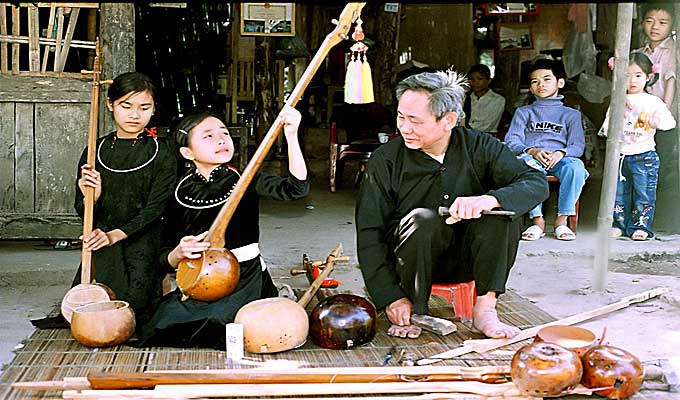The “Then” singing of Viet Nam’s Tay and Nung ethnic minority groups is of particular importance to people in the northeast region.
Bac Kan, one of Viet Nam’s cradles of “Then” singing, leads the effort to preserve the art form by teaming veteran artists with young artists who want to make Then music more relevant to modern society.
“Then” singing is a musical genre that uses a handmade gourd lute called a “Tinh Tau” or “Dan Tinh”. “Tinh” means a musical instrument and “Tau” is a type of gourd. Its three cords represent the tongues of the father, the mother, and the heaven and earth.

Singing “Then” songs is as much a part of the daily lives of Tay and Nung ethnic people as eating rice and drinking water.
Legend has it that there was man named Xien Can who couldn’t speak so he created a 12-cord gourd lute whose sound enchanted not only humans, but also all the animals, prompting the Jade Emperor to reduce the number of the instrument’s cords to three. The 3-cord gourd lute continues to enchant people.
“Then” singing is an intangible cultural heritage, combining folk culture and specific cultural characteristics of the ethnic group. A “Then” song accompanied by a “Dan Tinh” recounts a human’s journey to heaven to pray for prosperity, happiness, and a comfortable life.
“Then” is performed at rituals to ask for good health, bumper crops, and good fortune to bless a new home, and at maturity rituals. Today, “Then” singing is also considered an art form and is performed at festivals and social gatherings.
People in Bac Kan sing “Then” songs as if they were whispering or talking confidentially with somebody. It’s totally different from the cheerful way people in Lang Son, Cao Bang, and Tuyen Quang sing “Then”.
Artisan Ma Van Vinh who is well-known for his gourd lutes underlined the need to “preserve the Tay people’s culture of singing Then."
"I’m 66 years old now and think its time to hand down the tradition to future generations. That’s why I’ve set up clubs where old people gather to sing Then songs for other people to listen to and get interested in,” Vinh shared.
“Then” singing is an indispensable part of the spiritual and cultural life of Tay people. Bac Kan people are well aware of the need to conserve their ancient culture.
There are about six Then clubs in Cho Moi, Ba Be, and Cho Don district. The provincial culture center often offers summer courses in “Then” singing. The primary school in Chu Huong commune has added “Then” singing to its curriculum.
22-year-old La Thi Anh of Dong Vien commune is studying “Then” singing at Viet Bac Culture and Arts College. She said, “I first got interested in Then singing listening to old people in my village, who made a big impression. As a young person, I want to preserve the traditional folk tunes and hope that everyone will join efforts so that Then melodies will not get lost.”
Bac Kan’s culture sector has turned “Then” singing and “Dan Tinh” into a unique tourism product. A recent tourism, sports and culture festival of ethnic groups in the northeast region offered a great opportunity for Bac Kan’s Then to be introduced to people from other provinces.
La Bao Duy, head the Public Arts section of the provincial Culture Center, noted, “to prepare for the host province’s performance characterized by Bac Kan’s Then singing, we carefully selected artists who are outstanding singers in their district, collected Then melodies, and asked the artists to write new lyrics for the songs. We did our best to make Then as interesting as possible to visitors from neighboring provinces and other regions of Viet Nam.”
Tay people believe that Then has been handed down from their god, to enable the ethnic community to contact him and ask him for good health, bumper crops, happiness, and a long life.